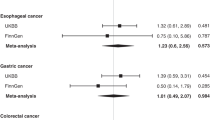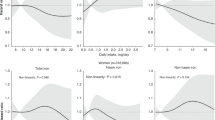Abstract
Background/Objectives:
Prospective cohort studies have indicated that serum vitamin D levels are inversely related to risk of type 2 diabetes. However, such studies cannot determine the source of vitamin D. Therefore, we examined the association of dietary vitamin D intake with incident type 2 diabetes within the European Prospective Investigation into Cancer and Nutrition (EPIC)-InterAct study in a heterogeneous European population including eight countries with large geographical variation.
Subjects/Methods:
Using a case-cohort design, 11 245 incident cases of type 2 diabetes and a representative subcohort (N=15 798) were included in the analyses. Hazard ratios (HR) and 95% confidence intervals (CIs) for type 2 diabetes were calculated using a Prentice-weighted Cox regression adjusted for potential confounders. Twenty-four-hour diet-recall data from a subsample (N=2347) were used to calibrate habitual intake data derived from dietary questionnaires.
Results:
Median follow-up time was 10.8 years. Dietary vitamin D intake was not significantly associated with the risk of type 2 diabetes. HR and 95% CIs for the highest compared to the lowest quintile of uncalibrated vitamin D intake was 1.09 (0.97–1.22) (Ptrend=0.17). No associations were observed in a sex-specific analysis. The overall pooled effect (HR (95% CI)) using the continuous calibrated variable was 1.00 (0.97–1.03) per increase of 1 μg/day dietary vitamin D.
Conclusions:
This observational study does not support an association between higher dietary vitamin D intake and type 2 diabetes incidence. This result has to be interpreted in light of the limited contribution of dietary vitamin D on the overall vitamin D status of a person.
This is a preview of subscription content, access via your institution
Access options
Subscribe to this journal
Receive 12 print issues and online access
$259.00 per year
only $21.58 per issue
Buy this article
- Purchase on Springer Link
- Instant access to full article PDF
Prices may be subject to local taxes which are calculated during checkout

Similar content being viewed by others
References
Maestro B, Campion J, Davila N, Calle C . Stimulation by 1,25-dihydroxyvitamin D3 of insulin receptor expression and insulin responsiveness for glucose transport in U-937 human promonocytic cells. Endocr J 2000; 47: 383–391.
Danescu LG, Levy S, Levy J . Vitamin D and diabetes mellitus. Endocrine 2009; 35: 11–17.
Kadowaki S, Norman AW . Dietary vitamin D is essential for normal insulin secretion from the perfused rat pancreas. J Clin Invest 1984; 73: 759–766.
Palomer X, Gonzalez-Clemente JM, Blanco-Vaca F, Mauricio D . Role of vitamin D in the pathogenesis of type 2 diabetes mellitus. Diabetes Obes Metab 2008; 10: 185–197.
Norman AW, Frankel JB, Heldt AM, Grodsky GM . Vitamin D deficiency inhibits pancreatic secretion of insulin. Science 1980; 209: 823–825.
Cade C, Norman AW . Vitamin D3 improves impaired glucose tolerance and insulin secretion in the vitamin D-deficient rat in vivo. Endocrinology 1986; 119: 84–90.
Chiu KC, Chu A, Go VL, Saad MF . Hypovitaminosis D is associated with insulin resistance and beta cell dysfunction. Am J Clin Nutr 2004; 79: 820–825.
Borissova AM, Tankova T, Kirilov G, Dakovska L, Kovacheva R . The effect of vitamin D3 on insulin secretion and peripheral insulin sensitivity in type 2 diabetic patients. Int J Clin Pract 2003; 57: 258–261.
Calle C, Maestro B, Garcia-Arencibia M . Genomic actions of 1,25-dihydroxyvitamin D3 on insulin receptor gene expression, insulin receptor number and insulin activity in the kidney, liver and adipose tissue of streptozotocin-induced diabetic rats. BMC Mol Biol 2008; 9: 65.
Pittas AG, Lau J, Hu FB, wson-Hughes B . The role of vitamin D and calcium in type 2 diabetes. A systematic review and meta-analysis. J Clin Endocrinol Metab 2007; 92: 2017–2029.
Mitri J, Muraru MD, Pittas AG . Vitamin D and type 2 diabetes: a systematic review. Eur J Clin Nutr 2011; 65: 1005–1015.
Pittas AG, Sun Q, Manson JE, wson-Hughes B, Hu FB . Plasma 25-hydroxyvitamin D concentration and risk of incident type 2 diabetes in women. Diabetes Care 2010; 33: 2021–2023.
Forouhi NG, Ye Z, Rickard AP, Khaw KT, Luben R, Langenberg C et al. Circulating 25-hydroxyvitamin D concentration and the risk of type 2 diabetes: results from the European Prospective Investigation into Cancer (EPIC)-Norfolk cohort and updated meta-analysis of prospective studies. Diabetologia 2012; 55: 2173–2182.
Khan H, Kunutsor S, Franco OH, Chowdhury R . Vitamin D, type 2 diabetes and other metabolic outcomes: a systematic review and meta-analysis of prospective studies. Proc Nutr Soc 2013; 72: 89–97.
Liu S, Song Y, Ford ES, Manson JE, Buring JE, Ridker PM . Dietary calcium, vitamin D, and the prevalence of metabolic syndrome in middle-aged and older US women. Diabetes Care 2005; 28: 2926–2932.
Pittas AG, Dawson-Hughes B, Li T, Van Dam RM, Willett WC, Manson JE et al. Vitamin D and calcium intake in relation to type 2 diabetes in women. Diabetes Care 2006; 29: 650–656.
Kirii K, Mizoue T, Iso H, Takahashi Y, Kato M, Inoue M et al. Calcium, vitamin D and dairy intake in relation to type 2 diabetes risk in a Japanese cohort. Diabetologia 2009; 52: 2542–2550.
Riboli E, Hunt KJ, Slimani N, Ferrari P, Norat T, Fahey M et al. European Prospective Investigation into Cancer and Nutrition (EPIC): study populations and data collection. Public Health Nutr 2002; 5: 1113–1124.
Langenberg C, Sharp S, Forouhi NG, Franks PW, Schulze MB, Kerrison N et al. Design and cohort description of the InterAct project: an examination of the interaction of genetic and lifestyle factors on the incidence of type 2 diabetes in the EPIC Study. Diabetologia 2011; 54: 2272–2282.
Margetts BM, Pietinen P . European Prospective Investigation into Cancer and Nutrition: validity studies on dietary assessment methods. Int J Epidemiol 1997; 26 (Suppl 1), S1–S5.
Slimani N, Deharveng G, Unwin I, Southgate DA, Vignat J, Skeie G et al. The EPIC nutrient database project (ENDB): a first attempt to standardize nutrient databases across the 10 European countries participating in the EPIC study. Eur J Clin Nutr 2007; 61: 1037–1056.
Barlow WE, Ichikawa L, Rosner D, Izumi S . Analysis of case-cohort designs. J Clin Epidemiol 1999; 52: 1165–1172.
Wareham NJ, Jakes RW, Rennie KL, Schuit J, Mitchell J, Hennings S et al. Validity and repeatability of a simple index derived from the short physical activity questionnaire used in the European Prospective Investigation into Cancer and Nutrition (EPIC) study. Public Health Nutr 2003; 6: 407–413.
Slimani N, Kaaks R, Ferrari P, Casagrande C, Clavel-Chapelon F, Lotze G et al. European Prospective Investigation into Cancer and Nutrition (EPIC) calibration study: rationale, design and population characteristics. Public Health Nutr 2002; 5: 1125–1145.
Slimani N, Ferrari P, Ocke M, Welch A, Boeing H, Liere M et al. Standardization of the 24-hour diet-recall calibration method used in the european prospective investigation into cancer and nutrition (EPIC): general concepts and preliminary results. Eur J Clin Nutr 2000; 54: 900–917.
Ferrari P, Day NE, Boshuizen HC, Roddam A, Hoffmann K, Thiebaut A et al. The evaluation of the diet/disease relation in the EPIC study: considerations for the calibration and the disease models. Int J Epidemiol 2008; 37: 368–378.
de Boer I, Tinker LF, Connelly S, Curb JD, Howard BV, Kestenbaum B et al. Calcium plus vitamin D supplementation and the risk of incident diabetes in the Women's Health Initiative. Diabetes Care 2008; 31: 701–707.
Ovesen L, Andersen R, Jakobsen J . Geographical differences in vitamin D status, with particular reference to European countries. Proc Nutr Soc 2003; 62: 813–821.
Elmadfa I, Weichselbaum E, Konig J, de Winter A MR, Trolle E, Haapala I et al. European nutrition and health report 2004. Forum Nutr 2005; 58: 1–220.
Fabian E, Elmadfa I . Nutritional situation of the elderly in the European Union: data of the European Nutrition and Health Report (2004). Ann Nutr Metab 2008; 52 (Suppl 1), 57–61.
Lips P . Vitamin D status and nutrition in Europe and Asia. J Steroid Biochem Mol Biol 2007; 103: 620–625.
Acknowledgements
We thank all EPIC participants and staff for their contribution to the study. We thank Nicola Kerrison (MRC Epidemiology Unit, Cambridge) for managing the data for the InterAct project. We further thank Valentina Gallo (Imperial College, London) for providing information on dividing the EPIC centres into latitude groups. The funding for the InterAct project was provided by the EU FP6 programme (grant number LSHM_CT_2006_037197). In addition, InterAct investigators acknowledge funding from the following agencies: E Ardanaz: Health Research Fund (FIS) of the Spanish Ministry of Health and Navarre Regional Government; JWJ Beulens: verification of diabetes cases in EPIC-NL was additionally funded by NL Agency grant IGE05012 and an incentive grant from the board of the UMC Utrecht; PW Franks: Swedish Research Council, Novo Nordisk, Swedish Diabetes Association, Swedish Heart-Lung Foundation; R Kaaks: German Cancer Aid, German Ministry of Research (BMBF); TJ Key: Cancer Research, UK; KT Khaw: Medical Research Council, UK, Cancer Research, UK; T Kühn: German Cancer Aid; P Nilsson: Swedish Research Council; K Overvad: Danish Cancer Society; JR Quirós: Asturias Regional Government; O Rolandsson: The Västerboten County Council; I Sluijs: verification of diabetes cases was additionally funded by NL Agency grant IGE05012 and an incentive grant from the board of the UMC Utrecht; AMW Spijkerman: Dutch Ministry of Public Health, Welfare and Sports (VWS), Netherlands Cancer Registry (NKR), LK Research Funds, Dutch Prevention Funds, Dutch ZON (Zorg Onderzoek Nederland), World Cancer Research Fund (WCRF), Statistics Netherlands; A Tjonneland: Danish Cancer Society; R Tumino: AIRE-ONLUS Ragusa, AVIS-Ragusa, Sicilian Regional Government; DL van der A: Dutch Ministry of Public Health, Welfare and Sports (VWS), Netherlands Cancer Registry (NKR), LK Research Funds, Dutch Prevention Funds, Dutch ZON (Zorg Onderzoek Nederland), World Cancer Research Fund (WCRF), Statistics Netherlands; R Zamora-Ros: the Health Research Fund (FIS) of the Spanish Ministry of Health (RTICC DR06/0020/0091); E Riboli: Imperial College Biomedical Research Centre.
Author information
Authors and Affiliations
Corresponding author
Ethics declarations
Competing interests
The authors declare no conflict of interest.
Rights and permissions
About this article
Cite this article
Abbas, S., Linseisen, J., Rohrmann, S. et al. Dietary vitamin D intake and risk of type 2 diabetes in the European Prospective Investigation into Cancer and Nutrition: the EPIC-InterAct study. Eur J Clin Nutr 68, 196–202 (2014). https://doi.org/10.1038/ejcn.2013.235
Received:
Revised:
Accepted:
Published:
Issue Date:
DOI: https://doi.org/10.1038/ejcn.2013.235
Keywords
This article is cited by
-
Vitamin D3 metabolite ratio as an indicator of vitamin D status and its association with diabetes complications
BMC Endocrine Disorders (2020)
-
The impact of vitamin D deficiency on patients undergoing kidney transplantation: focus on cardiovascular, metabolic, and endocrine outcomes
Endocrine (2015)
-
Bioavailability of vitamin D2 from enriched mushrooms in prediabetic adults: a randomized controlled trial
European Journal of Clinical Nutrition (2014)



